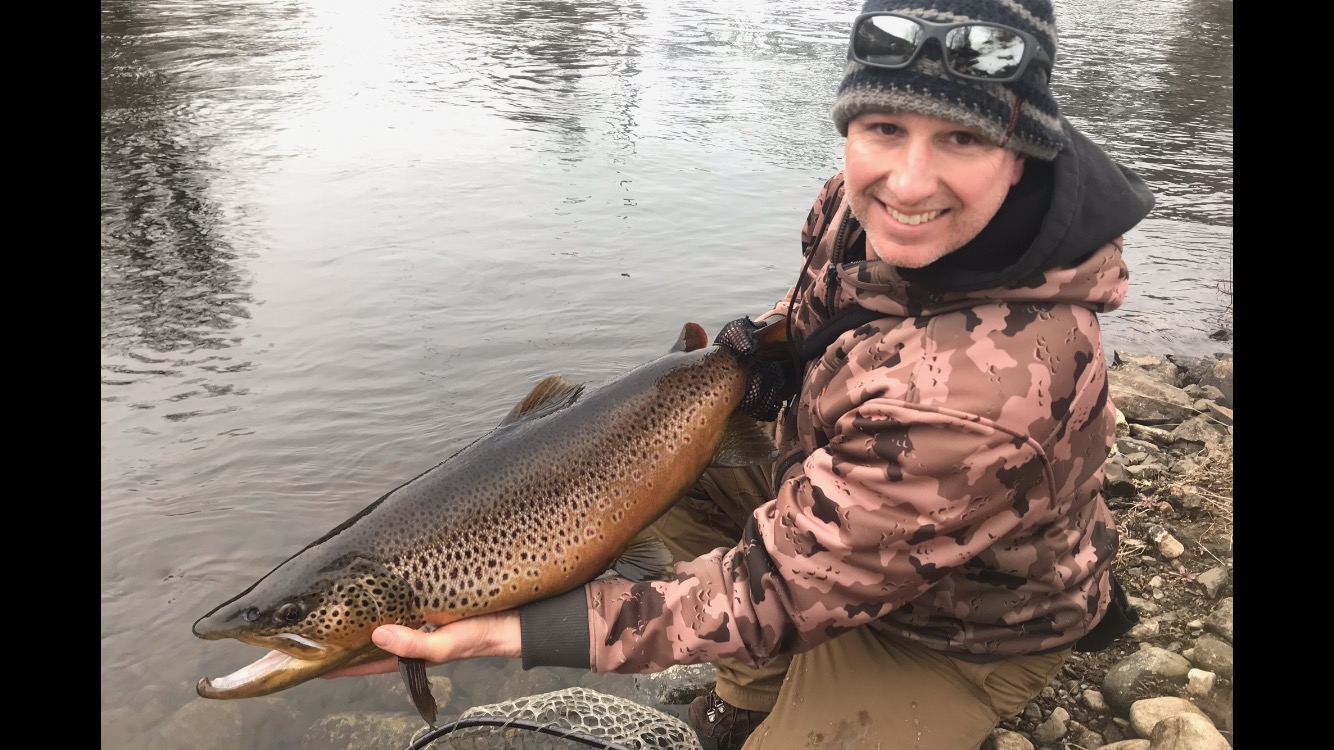The Deerfield River is one of the top fly-fishing destinations in New England and my top choice for trout fishing in the Berkshires.
It has some of the best public access of any river in the Berkshires and has trout fishing opportunities for almost it’s entire length. The Deerfield can be a frustrating river to wade if the power company is releasing water from Fife Brook dam, limiting anglers to the edges of holes, and making wading treacherous. Float fishing from a raft with an experienced guide is the safest and most productive way to fish the Deerfield during peak flows.
Know the Flow
Wade fishing is best when the water is at minimum flow from Fife Brook dam. To obtain flow information go to Safewaters.com and click on the link for Fife Brook dam. This should give you the current flow as well as the release schedule for the day. Develop a fishing strategy based upon what you see in the schedule. For example, a scheduled release in the summer usually occurs at 11am, which means the upper Catch and Release by Fife Brook will become difficult to wade fish after 11am- a good strategy to deal with this is to start early at the dam and quickly move hole to hole downriver to stay ahead of the release. If you are moving efficiently, you can enjoy low water fishing well into the afternoon. Conversely, the water releases in the warm months are usually three to four hours in duration- so you can return to Fife Brook after the release is over and enjoy more low water fishing after starting downriver in the morning-all of which to say it’s good to have a strategy in place when you visit the Deerfield River, or you’ll be scratching your head trying to figure it out.
The Deerfield has some slick rocks and highly educated trout, particularly in the Catch and Release area by the Fife Brook Fishing Access area. Be sure to include spiked wading soles, felt bottoms (or both) and a wading staff. Unscheduled releases are always a possibility on the Deerfield so always use caution- I like to pick out a rock as a visual aid while I’m fishing and take a mental note of where the water line is on your rock of choice-if you look over and see the water line moving up the rock that’s a cue to retreat to the bank. Sometimes the front of the release will have leaves and debris in it, if you see a debris line coming through that is another cue to get to the bank.
Fly selection
Fly selection varies throughout the year as it does on many rivers-as a rule of thumb I start big with larger offerings and heavier tippet and downsize both the flies and tippet if the trout are being fussy- you can count on fish being fussy at Fife Brook in the summer months. Don’t be afraid to experiment or think outside of the box as fish will get accustomed to seeing the same gold bead nymphs drift bye over and over- by mid-summer they’ll part like the Red Sea if you drift a size 14 bead head nymph through them.
Nymphing under an indicator, on a Euro setup, or under a big dry or hopper is still the most productive method for connecting with a trout on the Deerfield.
Here’s a dozen must have nymphs for the Deerfield River:
Pat’s Rubber Legs
This is a big morsel that could be a stonefly, a hellgrammite, or some other food. I prefer to fish these in a size 8 with a tungsten bead, particularly in the winter or early spring.
Bead Head Squirmy Worm
Some purists hate these flies but ignore them at your expense, aquatic and terrestrial worms are a big part of a trout’s diet, particularly after a rain event.
Flashback Tungsten Pheasant Tail
I like to run these in April and May when the trout are active on mayfly nymphs and a little flash can help your fly stand out.
Mercury Midge
Midges are always on the menu and fussy trout will take them on light tippet when all else fails.
Tungsten Prince Nymph
A classic pattern that you have to run through just to see, sometimes they get nutty for the princely Prince.
Bead Head Mop Fly
For years the Mop was the secret attractor pattern on the D that racked up big numbers. It’s still effective and one that every angler should have in their nymph box
Tight Line Clown Egg
Egg patterns can activate trout that are sulking or fussy and when there are eggs in the drift trout will feed on them to the exclusion of everything else-have multiple colors from orange to cheese, even green
LaFontaine Deep Sparkle Pupa
The Deerfield is a caddis dominant river and the pupal stage is often the most important, this classic pattern should be carried in a variety of sizes in green and tan.
Strolis’ Classified Caddis Pupa
Another great caddis pupa with the same requirements as the LaFontaine in terms of size and color.
Strolis’ Winter Stone
If you’re fishing in the late winter and early spring be sure to run on of these through- small winter stones are an important food source
Walts Worm
Is it a cranefly larva or a cased caddis? Only the trout know… but you’d be a fool not to have some in size 10-12 and 14 on the D.
Uke’s Brown Bug
This falls under the attractor pattern category and it’s a fly that I’ve become fond of as a searching pattern in the spring.
There you have it!
A dozen good nymphs that should yield results for you on the Deerfield River. If you want to learn more about the Deerfield River and fly fishing in the Berkshires book your trip today.
